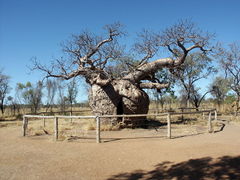Adansonia gregorii: Difference between revisions
Jump to navigation
Jump to search
Created page with 'a' |
No edit summary |
||
| (2 intermediate revisions by one other user not shown) | |||
| Line 1: | Line 1: | ||
a | {{SPlantbox | ||
|familia=Bombaceae | |||
|genus=Adansonia | |||
|species=gregorii | |||
|common_name=Baobab, Bottle Tree | |||
|name_ref=Flora - A Gardener's Encyclopedia | |||
|habit=tree | |||
|habit_ref=Flora - A Gardener's Encyclopedia | |||
|Min ht box=20 | |||
|Min ht metric=ft | |||
|Max ht box=40 | |||
|Max ht metric=ft | |||
|height_ref=Flora - A Gardener's Encyclopedia | |||
|Min wd box=3 | |||
|Min wd metric=ft | |||
|Max wd box=7 | |||
|Max wd metric=ft | |||
|width_ref=Flora - A Gardener's Encyclopedia | |||
|lifespan=perennial | |||
|life_ref=Flora - A Gardener's Encyclopedia | |||
|exposure=sun | |||
|sun_ref=Flora - A Gardener's Encyclopedia | |||
|features=flowers | |||
|flower_season=early spring, mid spring, late spring, early summer, mid summer, late summer | |||
|flower_ref=Flora - A Gardener's Encyclopedia | |||
|flowers=white | |||
|Temp Metric=°F | |||
|min_zone=8 | |||
|usda_ref=Flora - A Gardener's Encyclopedia | |||
|max_zone=10 | |||
|image=Derby boab, Western Australia.jpg | |||
|image_width=240 | |||
|image_caption=''Adansonia gregorii'', the Boab | |||
}} | |||
'''''Adansonia gregorii''''', commonly known as '''boab''', is a [[tree]] in the [[family (biology)|family]] [[Malvaceae]]. As with other [[baobab]]s, it is easily recognised by the swollen base of its trunk, which gives the tree a bottle-like appearance. Endemic to [[Australia]], boab occurs in the [[Kimberley region of Western Australia|Kimberley]] region of [[Western Australia]], and east into the [[Northern Territory]]. | |||
Boab is a medium sized tree ranging in height from 5 to 15 meters, usually between 9 and 12 metres, with a broad bottle-shaped trunk.<ref name=FloraBase>{{FloraBase | name = Adansonia gregorii | id = 4995}}</ref> Its trunk base may be extremely large; trunks with a diameter of over five metres have been recorded. Boab is [[deciduous]], losing its leaves during the dry winter period and producing new leaves and large white flowers between December and May.<ref name="FloraBase" /> | |||
==Cultivation== | |||
===Propagation=== | |||
===Pests and diseases=== | |||
==Varieties== | |||
==Gallery== | |||
<gallery perrow=5> | |||
Image:Upload.png| photo 1 | |||
Image:Upload.png| photo 2 | |||
Image:Upload.png| photo 3 | |||
</gallery> | |||
==References== | |||
<references/> | |||
<!--- xxxxx *Flora: The Gardener's Bible, by Sean Hogan. Global Book Publishing, 2003. ISBN 0881925381 --> | |||
<!--- xxxxx *American Horticultural Society: A-Z Encyclopedia of Garden Plants, by Christopher Brickell, Judith D. Zuk. 1996. ISBN 0789419432 --> | |||
<!--- xxxxx *Sunset National Garden Book. Sunset Books, Inc., 1997. ISBN 0376038608 --> | |||
==External links== | |||
*{{wplink}} | |||
{{stub}} | |||
__NOTOC__ | |||
Latest revision as of 02:17, 4 November 2010
| Adansonia gregorii subsp. var. | Baobab, Bottle Tree | |||||||||||||||||||||||||||||||||||||||||||||||||||||||
|---|---|---|---|---|---|---|---|---|---|---|---|---|---|---|---|---|---|---|---|---|---|---|---|---|---|---|---|---|---|---|---|---|---|---|---|---|---|---|---|---|---|---|---|---|---|---|---|---|---|---|---|---|---|---|---|---|

|
|
| ||||||||||||||||||||||||||||||||||||||||||||||||||||||
| ||||||||||||||||||||||||||||||||||||||||||||||||||||||||
Adansonia gregorii, commonly known as boab, is a tree in the family Malvaceae. As with other baobabs, it is easily recognised by the swollen base of its trunk, which gives the tree a bottle-like appearance. Endemic to Australia, boab occurs in the Kimberley region of Western Australia, and east into the Northern Territory.
Boab is a medium sized tree ranging in height from 5 to 15 meters, usually between 9 and 12 metres, with a broad bottle-shaped trunk.[1] Its trunk base may be extremely large; trunks with a diameter of over five metres have been recorded. Boab is deciduous, losing its leaves during the dry winter period and producing new leaves and large white flowers between December and May.[1]
Cultivation
Propagation
Pests and diseases
Varieties
Gallery
-
photo 1
-
photo 2
-
photo 3
References
External links
- w:Adansonia gregorii. Some of the material on this page may be from Wikipedia, under the Creative Commons license.
- Adansonia gregorii QR Code (Size 50, 100, 200, 500)
